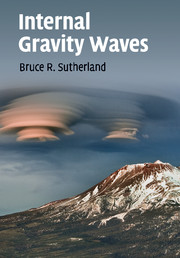Refine search
Actions for selected content:
8125 results in Fluid dynamics and solid mechanics

Internal Gravity Waves
-
- Published online:
- 05 October 2014
- Print publication:
- 02 September 2010
EFFECTS OF TIME DELAY ON THE DYNAMICS OF A KINETIC MODEL OF A MICROBIAL FERMENTATION PROCESS
- Part of
-
- Journal:
- The ANZIAM Journal / Volume 55 / Issue 4 / April 2014
- Published online by Cambridge University Press:
- 10 September 2014, pp. 336-356
-
- Article
-
- You have access
- Export citation
ANZ VOLUME 55 ISSUE 4 COVER AND FRONT MATTER
-
- Journal:
- The ANZIAM Journal / Volume 55 / Issue 4 / April 2014
- Published online by Cambridge University Press:
- 10 September 2014, pp. f1-f2
-
- Article
-
- You have access
- Export citation
A CLOSED-FORM PRICING FORMULA FOR VARIANCE SWAPS WITH MEAN-REVERTING GAUSSIAN VOLATILITY
- Part of
-
- Journal:
- The ANZIAM Journal / Volume 55 / Issue 4 / April 2014
- Published online by Cambridge University Press:
- 10 September 2014, pp. 362-382
-
- Article
-
- You have access
- Export citation
MOTION OF A SLIP SPHERE IN A NONCONCENTRIC FICTITIOUS SPHERICAL ENVELOPE OF MICROPOLAR FLUID
- Part of
-
- Journal:
- The ANZIAM Journal / Volume 55 / Issue 4 / April 2014
- Published online by Cambridge University Press:
- 10 September 2014, pp. 383-401
-
- Article
-
- You have access
- Export citation
ANZ VOLUME 55 ISSUE 4 COVER AND BACK MATTER
-
- Journal:
- The ANZIAM Journal / Volume 55 / Issue 4 / April 2014
- Published online by Cambridge University Press:
- 10 September 2014, pp. b1-b7
-
- Article
-
- You have access
- Export citation
6 - Vibroacoustic Boundary Value Problem
-
- Book:
- Advanced Computational Vibroacoustics
- Published online:
- 05 August 2014
- Print publication:
- 11 August 2014, pp 42-49
-
- Chapter
- Export citation
10 - Symmetric BEM without Spurious Frequencies for the External Acoustic Fluid
-
- Book:
- Advanced Computational Vibroacoustics
- Published online:
- 05 August 2014
- Print publication:
- 11 August 2014, pp 84-98
-
- Chapter
- Export citation
8 - Reduced-Order Computational Model
-
- Book:
- Advanced Computational Vibroacoustics
- Published online:
- 05 August 2014
- Print publication:
- 11 August 2014, pp 54-66
-
- Chapter
- Export citation
References
-
- Book:
- Advanced Computational Vibroacoustics
- Published online:
- 05 August 2014
- Print publication:
- 11 August 2014, pp 99-110
-
- Chapter
- Export citation
Contents
-
- Book:
- Advanced Computational Vibroacoustics
- Published online:
- 05 August 2014
- Print publication:
- 11 August 2014, pp v-viii
-
- Chapter
- Export citation
3 - External Inviscid Acoustic Fluid Equations
-
- Book:
- Advanced Computational Vibroacoustics
- Published online:
- 05 August 2014
- Print publication:
- 11 August 2014, pp 20-23
-
- Chapter
- Export citation
4 - Internal Dissipative Acoustic Fluid Equations
-
- Book:
- Advanced Computational Vibroacoustics
- Published online:
- 05 August 2014
- Print publication:
- 11 August 2014, pp 24-28
-
- Chapter
- Export citation
Subject Index
-
- Book:
- Advanced Computational Vibroacoustics
- Published online:
- 05 August 2014
- Print publication:
- 11 August 2014, pp 120-127
-
- Chapter
- Export citation
2 - Definition of the Vibroacoustic System
-
- Book:
- Advanced Computational Vibroacoustics
- Published online:
- 05 August 2014
- Print publication:
- 11 August 2014, pp 13-19
-
- Chapter
- Export citation
Author Index
-
- Book:
- Advanced Computational Vibroacoustics
- Published online:
- 05 August 2014
- Print publication:
- 11 August 2014, pp 117-119
-
- Chapter
- Export citation
5 - Structure Equations
-
- Book:
- Advanced Computational Vibroacoustics
- Published online:
- 05 August 2014
- Print publication:
- 11 August 2014, pp 29-41
-
- Chapter
- Export citation
Glossary
-
- Book:
- Advanced Computational Vibroacoustics
- Published online:
- 05 August 2014
- Print publication:
- 11 August 2014, pp 111-116
-
- Chapter
- Export citation
1 - Principal Objectives and a Strategy for Modeling Vibroacoustic Systems
-
- Book:
- Advanced Computational Vibroacoustics
- Published online:
- 05 August 2014
- Print publication:
- 11 August 2014, pp 1-12
-
- Chapter
- Export citation
7 - Computational Vibroacoustic Model
-
- Book:
- Advanced Computational Vibroacoustics
- Published online:
- 05 August 2014
- Print publication:
- 11 August 2014, pp 50-53
-
- Chapter
- Export citation
